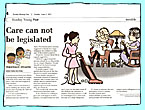| Overview |
Arguments are texts which we use to persuade people. ![]()
In some types of argument text we give people a number
of reasons why they should accept a particular point of view. We can use
this type of argument text to persuade people to accept our point of view
on an issue or to take some action. At other
times we use argument texts to analyse and discuss both sides of an issue
and make a judgement about the issue. Sometimes
we use them to challenge another person's point of view.
Arguments often use abstract, technical and scientific language.
Sometimes an argument will be a whole text in itself. At other times it may be
part of another text.
|
|
We use arguments when we want to persuade others to do something or to accept our point of view. In our daily lives we are always expressing opinions and giving reasons:
I think that Jackie Chan is better than Bruce Lee because ...
When we listen to or read arguments, we usually consider whether the reasons supporting the argument are strong or weak. A strong argument provides reasons which are factual and lead us to a logical conclusion. A weak argument may have strongly emotional reasons, but these reasons may not be based on fact or may not lead to a logical conclusion.
In school it is important that students learn how to present effective spoken and written arguments relevant to their studies. Effective arguments can be presented in the following ways:
| by identifying a point of view and organising evidence to support that point of view. | |
| by exploring different sides of an issue in order to make an informed judgement. | |
| by challenging another person's point of view and supporting the challenge with evidence. |
When students write effective arguments based on a topic studied at school, they show their teachers that:
| they have learned all the relevant information. | |
| they understand what they have learned. | |
| they select evidence to support their arguments from the knowledge they have gained while studying the topic. |
Arguments can be spoken or written texts. Spoken argument texts can include the following:

|
Political speeches, including speeches supporting or opposing
a bill in the Legislative Council, election speeches and speeches at public
protest meetings. |

|

|
Arguments
presented during news and current affairs programmes on radio and television. Arguments presented on radio or television to persuade people to do something for the public good, eg to stop smoking, to drive more carefully or not to litter. |

|
Arguments can also be written. Here are some Written argument texts include.

|
Letters to the editor of a newspaper. |

|

|
Posters, brochures and advertisements
to persuade people to do something for the public good, eg
to stop smoking, to drive more carefully or not to litter. Arguments written by school students to answer a question set by a teacher or examiner. |

|
When students read or write arguments, they do the following things with language:
|
introduce a point of view |
|
| provide background | |
| give reasons and evidence | |
| express positive and negative comments | |
| say what is probable and what is usual | |
| say what should happen and what can happen | |
| adjust the force and focus of an argument | |
| build a logical argument | |
| link clause to create an argument |
For more information on the different types of arguments see the menu on the
left.
In these pages you will find answers to the following questions:
|
How are arguments structured? |
|
|
What are the typical grammatical features of arguments? |
|
|
How can I use arguments in the classroom? |
|
||
To give us feedback about this section, click here or on the Comment button at the top of the screen.
If you have any questions about this section, visit the Language Corner.
If you have any questions or suggestions about how to teach this section, send a message to the Teaching Corner.